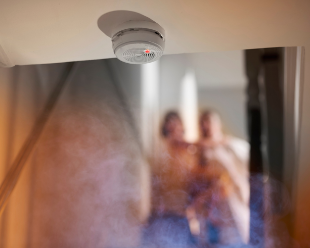
Did you check your smoke alarms this weekend when you put your clocks back for daylight savings? Did you discover they were not working and need to replace them?
Smoke alarms are a lifesaver. When your asleep, you lose your sense of smell. Don’t assume your smoke alarms are working. Smoke Alarms don’t last forever: they all have expiry dates and need to be replaced. It is important to maintain smoke alarms regularly and check that they are working.
Our handy guide will help you find the right smoke alarms to suit your home or office.
Fire and Emergency New Zealand recommends photoelectric alarms. All landlords are required to replace expired smoke alarms with long-life battery photoelectricc smoke alarms under The Residential Tenancy Act. Consumer.org thinks ionisation alarms should not be sold in New Zealand.
Photoelectric smoke alarms have 3 different battery types:
1. Long-Life Lithium Batteries – These are built in, sealed and generally last 10 years.
2. 9-volt Batteries - These will last about a year before they need replacing.
3. Hard-wired – You will need an electrician to wire in your smoke alarms and make sure the wired-in alarm has a backup battery installed incase of a power cut.
The New Zealand Building Code requires an approved smoke alarm to be fitted in every escape route (hallway) and within three metres of every sleeping space (bedroom) door. Fire and Emergency New Zealand goes further and recommends installing a smoke alarm in every bedroom, hallway and living area, on every level in the house. We suggest an alarm should be fitted in every bedroom and hallway at a minimum.

Alarms must be installed on or near the ceiling (because smoke rises). There’s evidence an upstairs alarm in a stairwell is likely to respond before one fitted downstairs, even when the fire is downstairs.
Along with a raft of other changes as a result of the leaky building crisis, the building code was changed in 2003 to require smoke alarms to be fitted to all residential buildings.
This doesn't mean that a council inspector will come knocking on your door to check if you have fitted the alarms. But it does mean that a code compliance certificate won't be issued - for any building work that requires a permit - until the alarms are fitted.
According to rules set down by the Building Code, smoke alarms must be "type 1" units. This means they must have a hush button - to allow nuisance alarms to be cleared without removing the battery - and also a test button.
As well, they must comply with at least one of the following standards:
• UL 217
• CAN/ULC S531
• AS 3786
• BS 5446:Part 1
The Residential Tenancies Act says every rental property must have working smoke alarms fitted at the start of a tenancy. New smoke alarms must be:
• photoelectric models with a battery life of at least eight years (or be hard-wired) and fitted according to manufacturer’s instructions
• installed within three metres of each bedroom door, or in every room where a person sleeps
• in each level or storey of a multi-storey or multi-level home
• in all rental homes, boarding houses, rental caravans, and self-contained sleep-outs (holiday lets are exempt).
If you need help with your smoke alarms, give us a call and we can come and assess whether your home and office is safe and compliant. 0800 688 244
Source: Consumer.org & Radio NZ



Get in touch to book a job or request free, no obligation advice.
Tell us a little about you and the project and we’ll be in touch, fast!